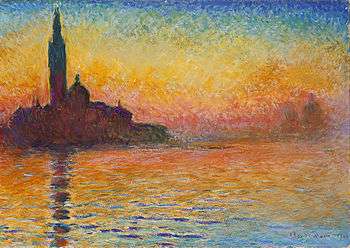San Giorgio Maggiore at Dusk
| San Giorgio Maggiore at Dusk | |
|---|---|
| French: Saint-Georges Majeur au Crépuscule, Italian: San Giorgio Maggiore al crepuscolo | |
 | |
| Artist | Claude Monet |
| Year | 1908–1912 |
| Medium | Oil on canvas |
| Dimensions | 65.2 cm × 92.4 cm (25.7 in × 36.4 in) |
| Location | National Museum Cardiff of Cardiff, Wales |
Saint-Georges majeur au crépuscule (Eng: Dusk in Venice, San Giorgio Maggiore by Twilight[1] or Sunset in Venice) refers to an Impressionist painting by Claude Monet, which exists in more than one version. Monet painted this subject as part of a series of views of the monastery-island of San Giorgio Maggiore. These were begun in 1908 when the 68-year-old artist made his only visit to Venice.
Version in Cardiff
One version of San Giorgio Maggiore at Dusk was acquired in Paris by the Welsh art collector Gwendoline Davies. She bequeathed it to the Art Gallery (now National Museum Cardiff) in Cardiff, Wales. The painting is normally on display there.[1][2]
Version in Japan
There is a version in the Bridgestone Museum of Art.

San Giorgio Maggiore al Crepuscolo: Description of the painting
San Giorgio Maggiore al Crepuscolo is approximately two-by-three feet and painted in oil on canvas. It depicts mysterious buildings that seem to magically appear from the surrounding landscape, they almost seem to float in the background. The forms are gently inserted, though not enough to disguise their identity. The painting focuses on the Church of San Giorgio Maggiore with its bell tower rising to the top of the painting. To the right are the faintly visible domes of Santa Maria della Salute and the mouth of the Grand Canal.
Monet in Venice
Monet painted the church of San Giorgio Maggiore in six lighting conditions. With this varied approach, the paintings focused on the ‘nature of experience.’ He was particularly impressed by the Venetian sunsets, “these splendid sunsets which are unique in the world.” He had previously been inspired by other sunsets, such as those of Normandy (in Rouen Cathedral and Haystacks, his series of the 1890s) and London (Houses of Parliament).

Viewpoints
Monet and his wife Alice stayed at the Palazzo Barbaro for a couple of weeks, and then moved to the Hotel Britannia, where they stayed until December.[5] According to Mme. Monet, the Britannia had a view, "if such a thing were possible, even more beautiful than that of Palazzo Barbaro..." Monet painted looking out from this hotel, but not, it seems, in the case of this particular painting. Although the view from the hotel included the church of San Giorgio Maggiore, the painting appears to have been viewed from the waterfront known as the Riva degli Schiavoni, where the island forms a focal point of the view.
Monet was reportedly reluctant to paint from the waterfront out of fear of conforming to other artists who were drawn to Venice, such as Renoir or Manet.[6] San Giorgio Maggiore was a favorite subject for painters, including the proto-Impressionist Turner.[7][8]
Completion of the paintings in France
Monet felt Venice was a city "too beautiful to be painted",[9] which may be why he returned with many paintings unfinished to Giverny, his home in France.[4] However, he had already retreated from his earlier practice of painting from life, in front of the subject. He worked on the Venetian scenes at home and the death of his wife Alice in 1911 seems to have been a factor in their completion. In 1912 he held a successful exhibition Claude Monet Venise at the gallery Bernheim-Jeune in Paris.
In popular culture
The painting became familiar in 1999 after its appearance in John McTiernan’s heist film The Thomas Crown Affair. In the film the picture is taken from the Metropolitan Museum of Art. In fact, the Metropolitan does not own the painting, although they have another of Monet's Venetian scenes The Doge's Palace Seen from San Giorgio Maggiore.
A Venetian painting by Monet was seized in July of 2016 by Swiss officials on behalf of U.S. authorities. It was described as being a painting of San Giorgio Maggiore. The owner, Jho Low, embezzled funds from 1Malaysia Development BHD., a government investment fund. He had purchased the painting for $35 million.[10]
See also
Other paintings from Monet´s Venetian series are to be seen in:
References
- 1 2 "San Giorgio Maggiore by Twilight". National Museum Wales (Welsh: Amgueddfa Cymru). Retrieved 31 January 2014.
- ↑ Williams, Sally (2010). "The Duck Pond That Grew into a 'French' Lake; How Did Claude Monet's Famous Paintings of Water Lilies Inspire Wales' Greatest Art-Collecting Sisters?". Western Mail. Retrieved 2014 via HighBeam Research (subscription required).
- ↑ "Twilight, Venice". Bridgestone Museum of Art. Retrieved 2 February 2014.
- 1 2 3 The Church of San Giorgio Maggiore, Venice, Indianapolis Museum of Art.
- ↑ The hotel's name has since changed to the Hotel Europa and Regina.
- ↑ Manet. Ritorno a Venezia. Musée d'Orsay
- ↑ Venice: San Giorgio Maggiore - Early Morning 1819
- ↑ Venice: San Giorgio Maggiore at Sunset, from the Hotel Europa 1840. Tate
- ↑ Claude Monet in Venice
- ↑ Crow, Kelly; Letzing, John (2016-07-21). "In the 1MDB Net, an Art-World Whale". Wall Street Journal. ISSN 0099-9660. Retrieved 2016-07-21.
- Brownjohn, John and Stephan Koja and Galerie Osterreichische, Claude Monet. New York: Prestel, 1996.
- Koja, Stephan and Katja Miksovsky, Claude Monet: the Magician of Colour. New York: Prestel, 1997.
- National Museum Wales, "San Giorgio Maggiore by Twilight Breaking Dawn," .
- Newcomb, Molly. "San Giorgio Maggiore at Dusk: Claude Monet." (2 April 2012)
- Pissarro, Joachim. Monet and the Mediterranean, New York: Rizzoli, 1997.
- Tucker, Paul Hayes and George T.M. Shackleford and Mary Anne Stevens, Monet in the 20th Century. New Haven: Museum of Fine Arts, 1998.
External links
| Wikimedia Commons has media related to Paintings of Venice by Claude Monet. |
